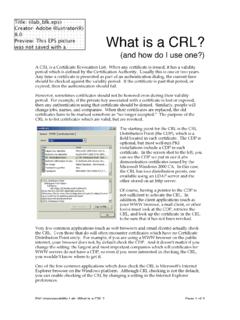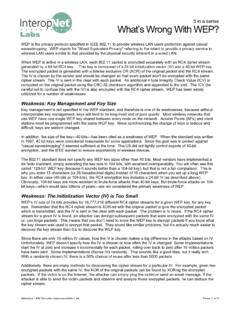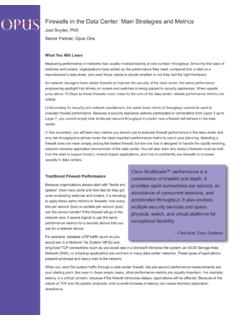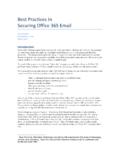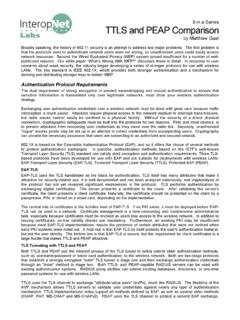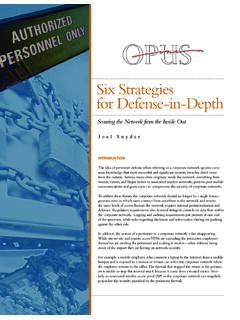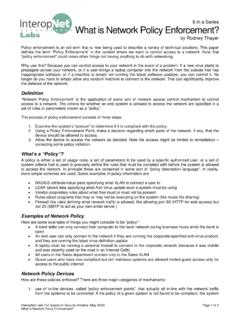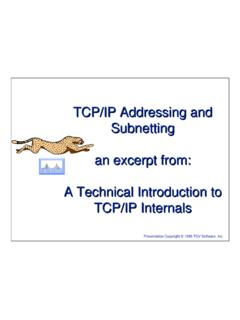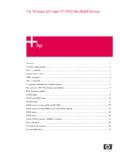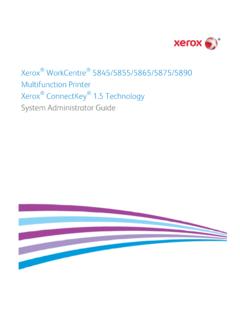Transcription of What are Your EAP Authentication Options?
1 4 in a series InteropNet Labs Full Spectrum Security Initiative (May 2005) Page 1 of 2 what are your EAP Authentication options ? what are your EAP Authentication options ? After you've decided to use Authentication for your wireless network, you have to make one of the most difficult and important decisions regarding its deployment. You must decide which EAP Authentication mechanism you will use. Although EAP supports a bunch of Authentication methods, only five are commonly used. They are: MD5, a one-way Authentication of supplicant to network using passwords; Cisco s proprietary username-based LEAP; TLS, which uses PKI-issued (public key infrastructure) digital certificates for strong mutual Authentication ; and TTLS and PEAP, which combine server-side certificates with some other Authentication such as passwords.
2 Not every supplicant supports every EAP Authentication method available. Not every RADIUS/EAP server supports every method. And not every access point supports all methods. Therefore, your choice of EAP Authentication method, drives everything else in your network. Summary of Common EAP Authentication Methods Method Description of Most Common Implementation Authentication Attributes WEP Key Generated? Deployment Difficulty Wireless Security EAP-MD5 Challenge-based password Authentication One-way NO Easy Poor LEAP Username/hashed password Authentication Mutual YES Easy Good.
3 If strong passwords are used EAP-TLS Certificate-based two-way Authentication Mutual YES Hard Best TTLS or PEAP Server Authentication via certificates; client via other method Mutual; identity hiding (opt) YES Moderate Better EAP-FAST Mutual Authentication using a PAC , second client Authentication via another EAP method Mutual; Identity hiding YES Easy to moderate, depending on security Better than LEAP; can be comparable to PEAP and TTLS with manual PAC distribution what is the MD5 Authentication Method?
4 The MD5 Authentication method is the simplest one available to wireless LAN users, and support is required in the EAP standard. However, the insecurity of MD5 in a wireless environment is so blatant that some wireless vendors have chosen not to allow MD5 as an Authentication method. With MD5 Authentication , the authenticator sends a challenge to the supplicant: some string, along with a serial number. The supplicant proves it knows the password by hashing the challenge, the string, and the password together and then sending the information back. Challenge-based Authentication schemes, like MD5, were designed to counter the insecurity of schemes like PAP (Password Authentication Protocol), which actually send the username and password in the clear across the wire.
5 With MD5 (or CHAP in traditional PPP), the password doesn t pass across the wire. Instead, the supplicant proves that it knows the password. MD5 requires that user passwords be stored in a way that lets the authenticator get at the original plain-text password. You ll sometimes hear this referred to as reversibly encrypted. This opens up the possibility of someone other than the Authentication server getting access to the file of passwords. Secondly, MD5 only authenticates the supplicant. It does nothing to authenticate the authenticator, , the wireless access point.
6 Since wireless is especially vulnerable to impersonation, this is a major problem. Whereas impersonating a dial-up access server on the other end of a phone line is fairly difficult, impersonating wireless just means getting within a couple hundred feet of the supplicant. This lack of mutual Authentication is the reason some wireless vendors have chosen not to allow MD5. Thirdly, MD5 does not create a WEP session key. Other Authentication methods, such as TLS and TTLS, support this but MD5 does not and therefore this limits its usefulness in the wireless world. what is the LEAP (Lightweight EAP) Authentication Method?
7 Lightweight EAP is also known as Cisco-EAP. It is a proprietary method defined by Cisco Systems. It uses a username/password pair to authenticate both the client and the Authentication server. It is easy to deploy and is widely deployed on Cisco and non-Cisco networks. However, it is susceptible to dictionary attacks, so it should only be used in wireless deployments where it can be assured that the users have strong passwords. 4 in a series InteropNet Labs Full Spectrum Security Initiative (May 2005) Page 2 of 2 what are your EAP Authentication options ? what is the TLS (Transport Layer Security) Authentication Method?
8 EAP-TLS is an IETF-standardized Authentication method based on the same protocol used for secure Web traffic via the SSL (Secure Sockets Layer) protocol. SSL, as initially developed by Netscape Corp. for use with its Web browsers and servers, is the protocol used by Web browsers and servers to negotiate an encrypted connection. When you use an https:// link, http-over-SSL is invoked and Authentication takes place automatically. There are very few differences between SSL version 3 and TLS. But as part of setting up the session, SSL starts with an Authentication phase, and that s what is being used in any EAP-TLS operation.
9 TLS Authentication within EAP is very simple. You take the TLS session establishment dialog between the supplicant and the Authentication server and pack each TLS message inside of an EAP-TLS packet. When the TLS Authentication dialog succeeds, the authenticator is informed and access to the network is granted. In EAP-TLS, certificates are used to authenticate the Authentication server to the supplicant, and to authenticate the supplicant to the Authentication server. The Authentication server starts by sending its digital certificate to the supplicant. The most common Authentication used today on the Web with SSL is one-way Authentication - a server sends its certificate to your browser to prove its identity.
10 However, with EAP-TLS, you are more interested in mutual Authentication so that you can protect your network against man-in-the-middle attacks. Because the certificates are sent over the air, EAP-TLS does not hide the identity of clients from eavesdroppers. The advantages of EAP-TLS make it a preferred Authentication method. Both wireless client and access points are strongly authenticated using digital certificates. As a side effect, a per-session WEP key is set up, and the client can be re-authenticated and re-keyed as often as needed without inconveniencing the end user at all.
